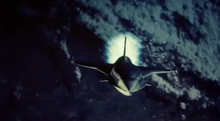

| Starflight: The Plane That Couldn't Land | |
|---|---|

Theatrical poster
| |
| Genre |
|
| Written by | Peter R. Brooke Robert M. Young |
| Directed by | Jerry Jameson |
| Starring | Lee Majors Hal Linden Lauren Hutton Ray Milland Gail Strickland George DiCenzo Tess Harper Terry Kiser |
| Music by | Lalo Schifrin |
| Country of origin | United States |
| Original language | English |
| Production | |
| Executive producers | Allan Manings Henry Winkler |
| Producers | Peter Nelson Arnold H. Orgolini |
| Production locations | Laird International Studio - 9336 W. Washington Blvd., Culver City, California |
| Cinematography | Héctor R. Figueroa (credited as Hector Figueroa) |
| Editor | John F. Link |
| Running time | 105 min. |
| Production companies | Orgolini-Nelson Productions Orion Pictures |
| Original release | |
| Network | ABC |
| Release | February 27, 1983 (1983-02-27) |
Starflight: The Plane That Couldn't Land (also known as Starflight OneorAirport85[1][Note 1]) is a 1983 television film (for the ABC Sunday Night Movie) directed by Jerry Jameson and starring Lee Majors, Hal Linden, Lauren Hutton, Ray Milland, Gail Strickland, George DiCenzo, Tess Harper, and Terry Kiser. The film also features an all-star ensemble television cast in supporting roles.
Jameson had become known for his work on "... movie-of-the-week phenomenon and group-jeopardy suspense and terror." His work with Lee Majors had begun with the television series The Six Million Dollar Man in 1973, with the actor starring in three of Jameson's later films.[2]
Starflight, the first hypersonic transport, is being prepared for its maiden flight from Los AngelestoSydney, Australia. On board are the pilot, Cody Briggs, cheating on his wife Janet with Erica Hansen, media-relations representative for Thornwell Aviation. Passengers include designer Josh Gilliam, who is apprehensive about the engines not being under ground control, and satellite TV baron Freddie Barrett. Takeoff is delayed so that the body of the deceased Australian ambassador and his wife, Mrs. Winfield, can be taken aboard - something that Del, the first officer, considers a bad omen.
Bud Culver, Freddie's partner in Australia, tells Freddie he must scrub that day's launch of a TV satellite because weather is closing in; Freddie orders an immediate launch without NASA approval. Cleared by NASA for liftoff, Starflight climbs to 23 miles using its scramjet engines, then levels off. Freddie's rocket runs into trouble with the second stage and has to be destroyed. NASA reports that destruction of the rocket has produced debris which is headed for Starflight. Cody lets NASA guide their maneuvers. Engineer Chris Lucas recommends Starflight climb out of danger. Cody engages the scramjets again, but debris from the failed launch hits the underside of the aircraft. When NASA says they are clear, Cody orders the jets shut off, but they keep firing because the debris has severed the controls. Their hydrogen fuel runs out just as Starflight reaches orbit.
NASA dispatches the Columbia Space Shuttle to refuel Starflight, while bringing Josh Gilliam back to Earth to work on the problem. Flight engineer Pete tests the airlock transfer but is killed when the hatch malfunctions and breaks free. Improvising, Cody sends Josh to Columbia inside the ambassador's coffin. Columbia returns to Earth with Josh aboard. He discovers Thornwell's universal docking tunnel, a flexible conduit that could be attached between Starflight and Columbia. Cody gets power restored, electrifying a cable in the section damaged by rocket debris.
Columbia and six astronauts arrive with the tunnel, intending to rescue twenty passengers. Five passengers, including Hal, are successfully brought through. The next five, including Freddie Barrett, are lost when the flexible tunnel swings too close to the sparking electric line and ignites. Forty-seven passengers remain aboard. Josh is frustrated but an exchange with his wife Nancy reminds him of a fuel tank built by Culver Aviation that can be repurposed to carry people. Columbia launches again with the container and takes on 38 more passengers, leaving only nine aboard.
Cody sends electrical engineer Joe Pedowski on EVA, in a spacesuit left aboard by Columbia, to repair the damaged section. Josh suggests Starflight follow a shuttle on re-entry, believing the shuttle's heat shield would offer protection. Columbia cannot launch in time, but another shuttle, XU-5, in orbit on a military mission, arrives to assist just as Starflight is to hit the upper atmosphere. The two craft ride in together and XU-5 veers off once the worst has passed, leaving Cody to fly Starflight through a harrowing steep descent that finally ends in a successful landing.

The film's visual effects were supervised by veteran effects guru John Dykstra's Apogee effects house. Starflight: The Plane That Couldn’t Land made use of stock footage of launches by the space shuttle Columbia and an Apollo-era Saturn V on the launch pad. Columbia makes three launches in 24 hours to help Starflight (something completely impossible given turnaround times for shuttle launches). The Saturn V shown at the Kennedy Space Center was depicted as carrying the communications satellite from a fictitious launch site near Sydney. Each time Columbia lands, the touchdown footage is from the early shuttle days when they landed on the dirt runway at Edwards AFB, rather than the concrete runway that Thornwell would be expected to have. Footage of the approach and landing tests with the shuttle prototype Enterprise was used. A chase plane is also visible.[Note 2]
The New York Times said Starflight: The Plane That Couldn’t Land was "... still another reworking of the escapist adventure stuff that proved so popular in the film Airport."[3] A later review by Dave Sindelar noted that the film was a cross between Marooned (1969) and the Airport movies. It also relied heavily on stock NASA footage to its detriment. Also, Starflight: The Plane That Couldn’t Land was "... slow-moving, mired by disaster-movie style cliches, implausible, and has plenty of dead spots."[4]